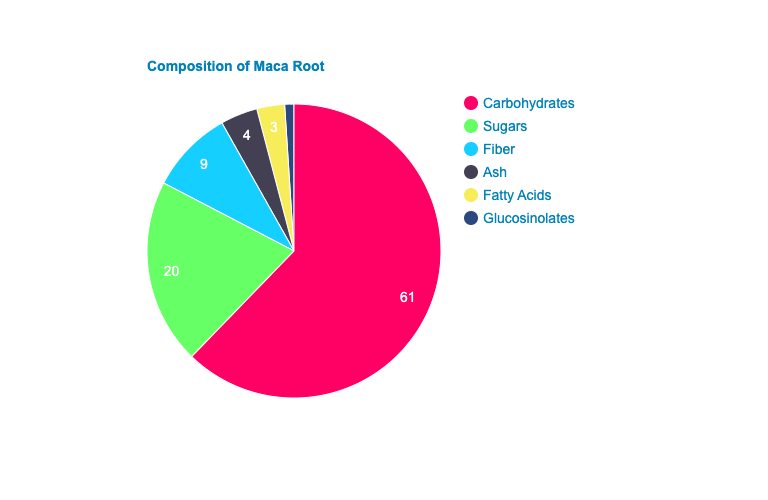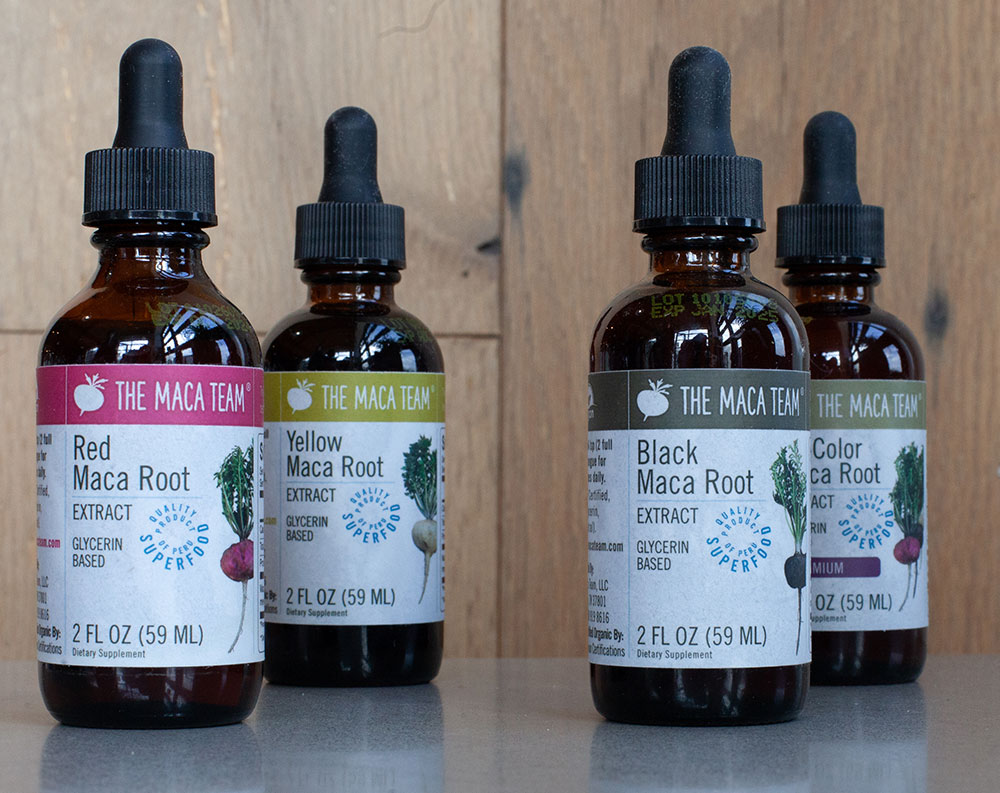Maca Nutrition Facts
What is maca’s complete nutritional profile?
Maca root is rich in plant-based protein, fiber, essential amino acids, vitamins (B1, B2, C, E), and minerals (iron, calcium, potassium, and magnesium). It grows natively in the high Andes of Peru and Bolivia and has been used for 1000s of years by natives to the area. In the past 30 years, it has come to be used by people worldwide due to its many potential health benefits.
Among all superfoods, maca root has a unique nutrient profile.
In this article well explain the nutrition facts of maca in as much detail as possible. The data below has been compiled from both nutritiondata.com as well as research published on PubMed.
Unless otherwise noted, all values listed below are based upon a single 10 gram serving of maca root.

The Chemical Composition of Maca
Maca is composed of the following in order of greatest to least. Note that some of these values will vary slightly from different harvests and batches of maca. Because of that other sources may cite different nutritional values for maca.
- 61% Carbohydrates

- 20% Sugars
- 9.8% Fiber
- 4.9% Ash (mineral content)
- 3.2% Fatty Acids
- 1% Glucosinolates
- .1% Sterols
Calories in Maca
- 32.5 in a 10 gram serving
- 77% from Carbohydrates
- 18% from Protein
- 5% from Fats
Protein Content In Maca
Maca contains 1.6 g of protein in a 10g serving size. The protein in maca is bio-available plant protein that is easy for the body to assimilate.
Maca Nutritional Values – Based on one 10 g serving
Essential Amino Acids
Maca contains nearly all of them. These drive many cellular functions in the body including sexual and fertility functions. Based on one 10 g serving.
- Alanine – 6.3 mg
- Arginine – 9.9 mg
- Aspartic Acid – 9.2 mg
- Glutamic Acid – 15.7 mg
- Glycine 6.8 mg
- Histidine – 4.2 mg
- HO-Proline – 2.6 mg
- Isoleucine – 4.78 mg
- Leucine – 9.1 mg
- Lysine – 5.5 mg
- Methionine – 2.8 mg
- Phenylalanine – 5.5 mg
- Proline - .05 mg
- Sarcosine - .07 mg
- Serine -- 5.0 mg
- Threonine – 3.3 mg
- Tryptophan - .5 mg
- Tyrosine – 3.0 mg
- Valine- 7.3 mg
Free Fatty Acids
20 have been found in Maca. These also work to support cellular function. Saturated acids account for 40% and non-saturated about 55%. The most abundant fatty acids adding to maca’s nutritional value are linolenic acid, palmitic acid, oleic acid and steric acid. Based on one 10 g serving. (mcg = microgram or 1/1000th of a milligram)
- C12-0 -lauric – .18 mcg
- C13-1-7 trideconoic – .07 mcg
- C13-0 tridecoanoic – .02 mcg
- C14-0 myrstic – .31 mcg
- C15-1-7 pentadecanoic – .11 mcg
- C16-1-9 palmtoleic – .59 mcg
- C16-0 palmitic – 5.24 mcg
- C17-1-9 heptadecenoic – .33 mcg
- C17-0 heptadecanoic – .41 mcg
- C18-2-9-12 linoleic – 7.17 mcg
- C18-1-9 oleic – 2.44 mcg
- C18-0 steric – 1.47 mcg
- C19-1-11 nonadecenoic – .28 mcg
- C19-0 – nonadecanoic – .08 mcg
- C20-1-15 eisosenoic – .51 mcg
- C22-0 behanic .44 mcg
- C24-1-15 nervonic – .09 mcg
- C-24-0 lignocenic – .09 mcg
Vitamins In Maca
- Thamin (B1) – 1 mcg – helps the body convert carbohydrates into energy. Essential for good heart, muscle and nervous system function
- Riboflavin (B2) - .7.6 mcg – important for body growth and red blood cell production
- Ascorbic Acid (C) - – 30 mcg – supports anti-oxidant activity
- Niacin 350 mcg – supports healthy circulation

Major Minerals In Maca
- Calcium – 4.5 mg – Maca contains a higher level of calcium than does milk. Calcium is crucial in bone development as well as for nerve and circulatory system health.
- Phosphorus – 2.2 mg – Phosphorus is important for the hemostasis of calcium as well as for transmitting electrical stimuli for brain and muscle action.
- Magnesium – 1.04 mg – Magnesium is essential for the synthesis of protein and for muscle and nerve activity. Crucial for heart health.
- Potassium – 15 mg – Potassium works within the cells to help maintain healthy osmosis.
- Sodium .25 mg – Along with potassium can support positive circulation
Minor Minerals In Maca
- Iodine - 5 mcg – Supports thyroid health
- Copper – .5 mcg – Supports enzyme health
- Zinc – 12 mcg – Helps in clarity of thought and mental function
- Manganese – 8 mcg – Supports healthy growth
- Iron – 25 mcg – Vital component of hemoglobin. Supports healthy muscle growth
- Selenium – 20 mcg – Protects cells against free radicals
- Boron – 5 mcg – Supports proper metabolism.
Sterols In Maca
With regular use, sterols may have a positive impact on lowering blood cholesterol. This is the breakdown of sterols found within maca root.
- Brassicasterol – 9.1%
- Ergosterol – 13.6%
- Campesterol – 27.3%
- Ergostadienol – 4.5%
- Sitoserol – 46.5%
Sugars In Maca
Raw Maca contains 2g sugar per 10g and Gelatinized Maca contains 4g per 10g. These sugars are naturally occurring fruit sugars. However diabetics should consume with caution. Our liquid Maca extracts are suitable for diabetics.
Glucosinolates
Maca contains the following aromatic glucosinolates:
- benzyl glucosinolate
- p-methoxybenzyl glucosinolate
- fructose
- glucose
- benzyl isothiocyanate
In food-bearing plants, glucosinolates act as natural pesticides and are stored in the plant’s cells, ready to be released upon tissue damage. Similarly, when consumed by humans, the action of chewing releases the glucosinolates into the body, where they are transformed into bioactive compounds believed to have anticancer properties.
Macaenes and macamides: (Macaina 1, 2, 3, 4)
These are polyunsaturated acids and their amides which are absolutely unique to Maca
Maca’s Nutritional Profile - FAQs
How many calories are in maca root powder per serving?
A standard 3 gram (about 1 tablespoon) serving of maca powder contains about 35 calories, which makes it a low-calorie superfood addition to any diet.
Is maca high in protein?
Yes, maca contains between 14-16% protein content. This makes maca an excellent source of plant-based protein.
What vitamins and minerals are found in maca root?
The major vitamins in maca root are B1, B2, and Niacin. Raw maca powder also is contains Vitamin C.
Does maca contain fiber?
Yes, maca root contains approximately 10% fiber.
What is the glycemic index of maca root?
Maca has a low glycemic index (GI) at 55. Maca does not cause spikes in blood sugar and is considered suitable for diabetics and for weight management. Read more on maca's sugar content.
Does maca contain any antioxidants?
Yes! Maca contains polyphenols and glucosinolates, which are known to help fight oxidative stress and support cellular health.
How does maca’s nutrient profile compare to other superfoods?
Compared to ginseng or ashwagandha, maca provides higher protein and fiber content, along with unique adaptogenic properties that are likely due to the presence of two acids unique to maca root called macaenes and macamides
Is maca a good source of amino acids?
Yes, maca contains a complete profile of aminos. It contains all 9 aminos that are considered essential. And it contains significant amounts of 19 o f the 22 known aminos. This makes maca an excellent choice for muscle recovery and vegan diets.
Does maca contain omega fatty acids?
Maca has small amounts of omega-3 and omega-9 fatty acids, contributing to heart and brain health.
How many carbohydrates are in maca root?
A 9 gram (1 tablespoon) serving of maca root contains 7g of carbohydrates, which would account for 2% of the RDA for that nutrient. Maca is considered keto friendly.
Does maca contain iron, calcium, or magnesium?
Yes! Maca is a good plant-based source of iron (good for energy), calcium (supports bones), and magnesium (reduces stress and cramps).
Is maca considered a high-energy superfood?
Absolutely! Thanks to its B vitamins, iron, and amino acids, maca is often called a natural energizer without caffeine.
Does maca have electrolytes?
Yes, maca contains potassium and sodium, which help with hydration, muscle function, and endurance.
Beyond Maca Nutrition Facts – Maca as an Adaptogen
The Maca Nutrition Facts listed above show that Maca is a true nutritional powerhouse and amazing daily food to include in your diet.
But Maca root, like the Chinese herb ginseng, is also an adaptogen. Adaptogens are substances that raise the physical body’s state of resistance to diseases through physiological and emotional health improvements. This makes maca a broad-based healer with many benefits able to support and rejuvenate overwhelmed, tired adrenal glands eventually resulting in much greater energy, stamina, clarity of mind and spirit, and the ability to handle stress.
One other important note is that scientists have also discovered that due to Maca’s nutritional value, the food has the ability to regulate, support, and balance the hormonal systems of both men and women for optimal function. One of the great things about Peruvian Maca root is that it works equally well for both men and women.
We hope this article gives you a great overview of Maca nutrition facts and what makes it such a powerful superfood. If you have any questions please contact us. We're happy to help.
Learn more about Maca
Enjoy the day!
![]()
